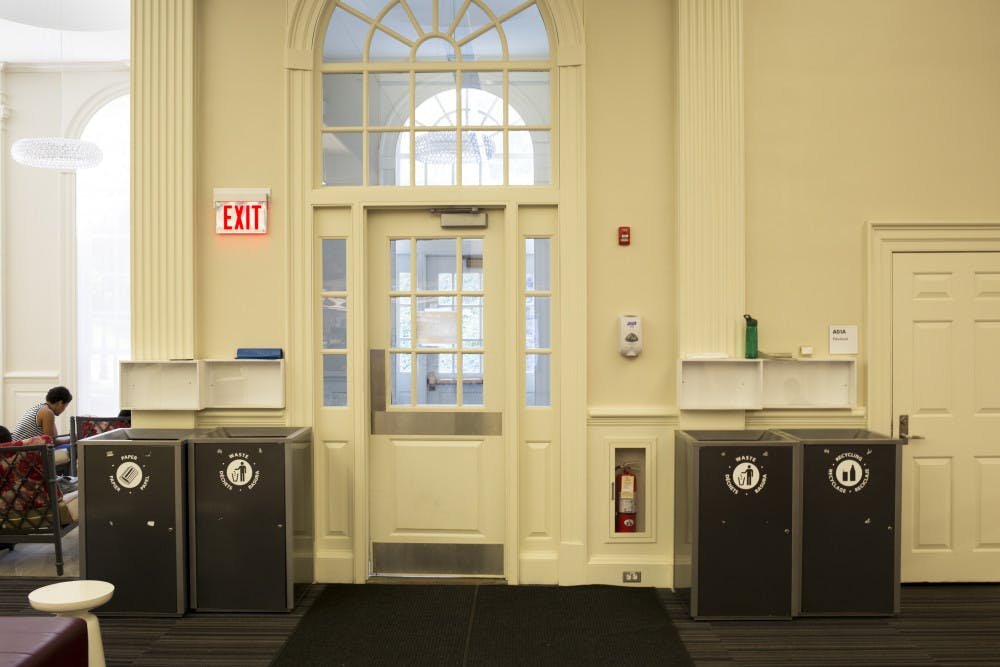The University has discontinued the composting program in Andrews Commons following the end of the pilot program last semester. The Office of Energy and Environment is currently weighing strategies for proceeding with sustainability efforts in regards to composting.
Brown is the only Ivy League institution besides Princeton that does not have a robust composting program in place. The bins in Andrews last semester were part of a $9,000 pilot program led by the Office of Energy and Environment, Brown University Dining Services and the Department of Facilities Management that would help the University later implement a campus-wide composting system, The Herald previously reported.
Compost diverts refuse from landfills, which are sources of toxic gases like methane, and puts those materials back into good use, often as fertilizer. Organic fertilizer from compost is better for the environment than synthetic fertilizers, which contain chemicals that can harmfully disrupt ecosystems.
During the first two weeks of last semester’s pilot program, nearly 100 student volunteers stood by the compost bins at Andrews and assisted their peers in choosing which receptacle to place their refuse in. With the volunteers in place, composting went very well, said Chris Powell, director of sustainable energy and environmental initiatives. The contamination rate — the amount of non-compostable items in the load — was between 5 and 10 percent. But once the volunteers left, the rate of contamination increased to 20-25 percent.
“The contamination rate is going to be the determining factor,” Powell said. Earth Care Farms, where the University’s compost was processed, is small and the contaminants are sorted out by hand. Once the contamination rate is as high as 20-25 percent, the labor becomes too expensive so the facility rejects the load and it goes into the landfill, rendering campus effort futile.
The University has to ensure that all of the products stocked in eateries are compostable. Certain items are compostable in some facilities but not in others. For example, the clear plastic-seeming cups that are “compostable” at many eateries require that the compost facility have a heat-based system, said Jessica Berry, sustainability program manager for sustainable energy and environmental initiatives. The small-scale compost facilities near the University do not have the necessary equipment to process those cups, she added. Another problem was that once people saw those kinds of cups in the compost bins, regular, non-compostable plastic cups often got tossed in alongside them, Berry said.
The pilot program increased rates of recycling, Powell said. “Our recycling rate increased markedly because you’ve got this education campaign and it was incredible. We actually got to the point where we had two trash dumpsters in the back of that building and we had to pull one of the trash dumpsters and switch it to a recycling dumpster,” he added.
Rhode Island’s landfill earned itself a “Dirty Dozen” award in 2012 for being one of the top 12 polluters in New England. The state recently passed a law, slated to go into effect Jan. 1, mandating that institutions that generate at least two tons of organic waste per week and are within a 15-mile radius of a composting facility must compost their biodegradable waste. Brown is one of three institutions that fit the criteria and are planning to launch composting programs, Powell said. But the nearby compost facilities available may not have the capacity for the refuse from these three institutions, he said. The state’s Department of Environmental Management is waiting for new compost facilities to be built that have anaerobic digesters to help facilitate the breakdown of organic waste. Until those facilities are completed, it is unlikely that the law will go into full effect, he added.
Powell said he is hopeful that as composting becomes compulsory, more vendors will get into the game, driving down operational costs. Currently, compost is $200 per ton as opposed to trash, which is $59 per ton. But the cost for trash does not encompass hauling fees and dumpster rentals, making the two options closer in price, Powell said.
New ideas are already being discussed to lower the contamination rate. One strategy would be to place the compost bin in a separate location from the trash bins so that students have to be conscious of what they throw away and won’t mistakenly throw trash into the compost bin, Berry said. Another is to display monitors and utilize postering to help educate students about what items are compostable. A serious plan being developed over the next academic year will consider the unique conditions of each eatery, said Isabelle Aubrun ’16, a sustainability intern for dining services.
“It’s an extra effort, but… the benefits are widespread and many fold,” she said. “The contribution we can make as a University is pretty significant. We have a footprint and we have the ability to do something about it.”





